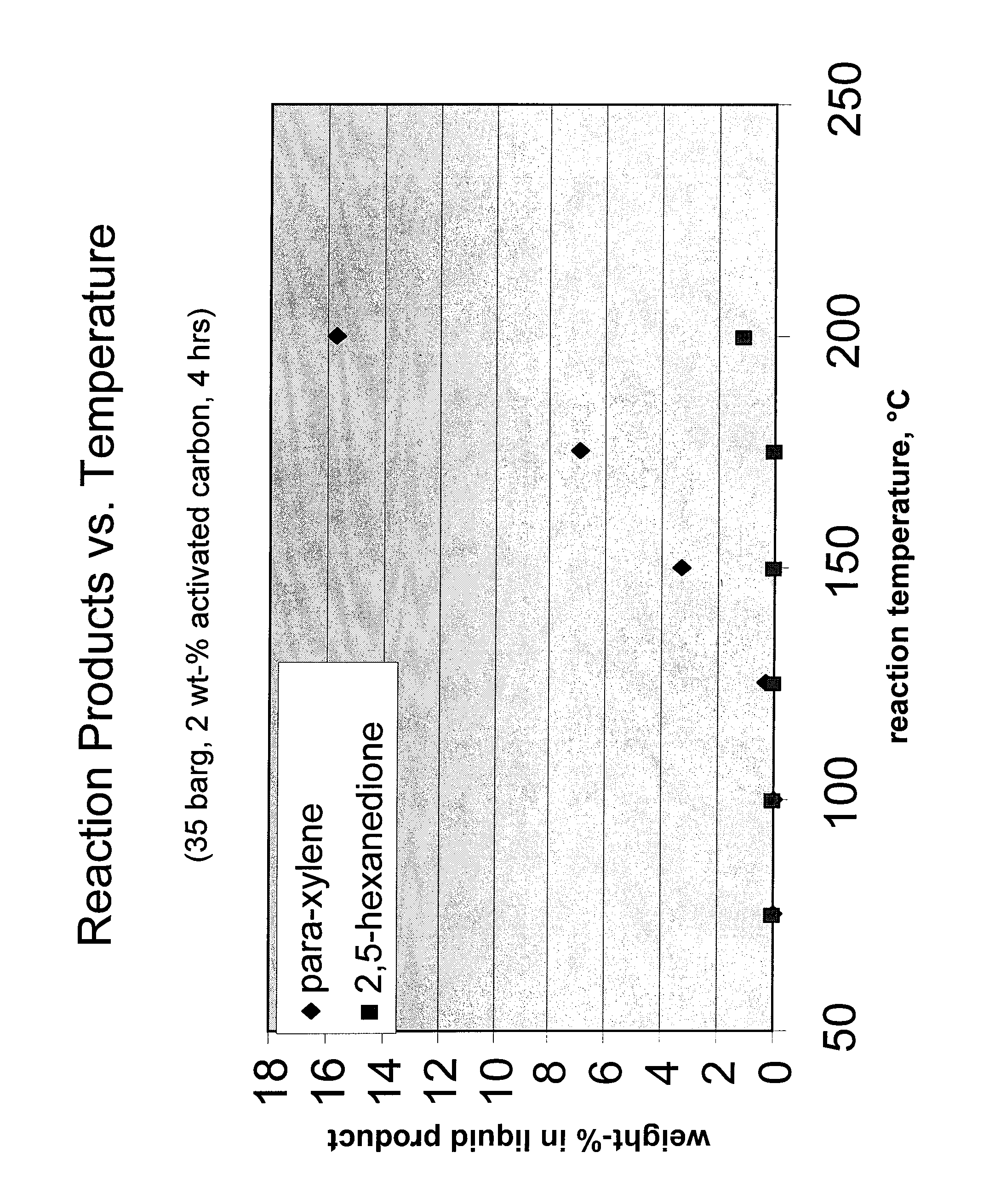Carbohydrate route to para-xylene and terephthalic acid
a carbohydrate and para-xylene technology, applied in the field of para-xylene production, can solve the problems of high cost and potential environmental consequences, and hinder the progress in some important areas
- Summary
- Abstract
- Description
- Claims
- Application Information
AI Technical Summary
Benefits of technology
Problems solved by technology
Method used
Image
Examples
example 1
Catalyst Screening Studies
[0027]The experimental procedure described in Comparative Example 1 was repeated in several additional autoclave tests, but in each case with the addition of a solid catalyst in a particle form (granular or powdered) at addition amounts of about 2% by weight, relative to DMF. Also, some of these screening tests were performed at 175° C. (347° F.) in addition to 150° C. (302° F.). The catalysts tested were ZnCl2, rare-earth exchanged Y zeolite (RE-Y), activated carbon, silica gel, and γ-alumina. By introducing a solid catalyst into the autoclave, the amount of para-xylene in the reaction liquid at the end of the 24-hour reaction period was substantially increased, relative to Comparative Example 1, for all catalysts tested. For tests using 2% by weight of activated carbon, the para-xylene amount exceeded 40% by weight.
example 2
Catalytic Activity of Activated Carbon Samples
[0028]A number of commercial activated carbon samples from Norit Americas, Inc. (Marshall, Tex. USA), Japan EnviroChemicals (Tokyo, Japan), Jacobi Carbons AB (Kalmar, Sweden), and Calgon Carbon Corporation (Pittsburgh, Pa.) were tested using the experimental procedures according to Example 1. Granular carbons were sized to less than 100 mesh (0.15 mm). The samples had BET surface areas ranging from 700-1300 m2 / gram and total pore volumes (measured by nitrogen adsorption) ranging from 0.45-1.2 cm3 / gram. The use of acid washing for activation of the carbon resulted in a total oxygen content ranging from 1% to as high as 18% by weight for the activated carbon samples that were tested.
[0029]For the best-performing activated carbon samples, the liquid product after the reaction period contained 40-55% by weight of para-xylene, and the para-xylene accounted for 65-78% of the total weight of all converted materials, indicating good selectivity ...
example 3
Effect of Reaction Temperature
[0030]One of the activated carbon samples used as a catalyst in Example 2 was tested in a number of autoclave experiments as described in Example 1, but with varying reactor temperatures and a total reaction time of only 4 hours. The composition of the liquid product as a function of temperature is shown in FIG. 1. The results showed that DMF conversion and para-xylene yield were both increased substantially with increasing reactor temperature, while the yield of byproduct HDO remained comparatively low at all temperatures. The commercial feasibility of a DMF to para-xylene step in an overall carbohydrate-based conversion process was therefore demonstrated.
PUM
| Property | Measurement | Unit |
|---|---|---|
| temperature | aaaaa | aaaaa |
| reactor residence time | aaaaa | aaaaa |
| surface area | aaaaa | aaaaa |
Abstract
Description
Claims
Application Information
 Login to View More
Login to View More - R&D
- Intellectual Property
- Life Sciences
- Materials
- Tech Scout
- Unparalleled Data Quality
- Higher Quality Content
- 60% Fewer Hallucinations
Browse by: Latest US Patents, China's latest patents, Technical Efficacy Thesaurus, Application Domain, Technology Topic, Popular Technical Reports.
© 2025 PatSnap. All rights reserved.Legal|Privacy policy|Modern Slavery Act Transparency Statement|Sitemap|About US| Contact US: help@patsnap.com

